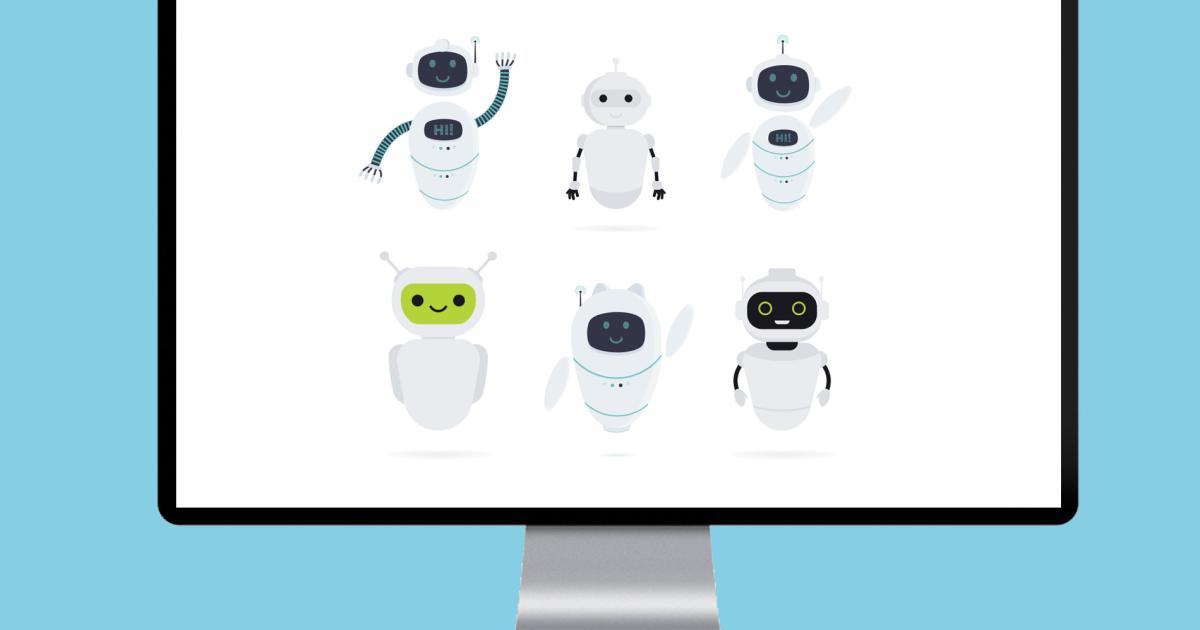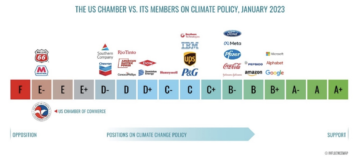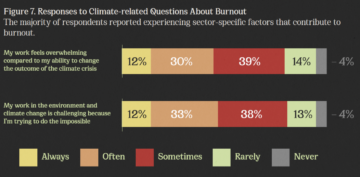
Ask a question, get an answer — maybe even a good one.
It’s time to move past the hype about (and imaginary conversations with) AI chatbots — computer programs designed to simulate conversation with human users — and assess their value to sustainability professionals in near-real-world circumstances.
In the world of artificial intelligence and chatbots, it’s very early days of what appears will be a rocket ride of innovation. ChatGPT, one of the better-known tools of this type, is barely six months old, although its growth is phenomenal.
One measure: It took Spotify 4.5 years to reach 100 million active monthly users. It took Instagram 2.5 years. ChatGPT got there in just two months, according to Paul Baier, an AI consultant who is working with, among others, Harvard Business School on AI strategy.
In the world of artificial intelligence and chatbots, it’s very early days of what appears will be a rocket ride of innovation.
ChatGPT may be the best known of the generative AI engines — a type of artificial intelligence technology that can produce various types of content, including text, imagery, audio and data — but it’s hardly the only one. Here’s a list of 131 chatbots built on the ChatGPT platform. There are several other platforms, each with its own spinoff chatbots. No doubt, there will be countless more. (And those are primarily English language bots. China, for example, has Ernie, which debuted in March.)
So, what’s the value of all this to a sustainability professional? Answering that question is a fast-moving target, as generative AI technology progresses at an astonishing rate. The best-known use for chatbots is to pose complex, plain-English questions and get lengthy and somewhat detailed answers. (More on that in a minute.)
The next level of sophistication enables a user to plug in a large amount of text — a scientific report, a speech, a magazine article, a memo, maybe all of the above — and ask a chatbot to summarize everything, picking out the most salient points.
Increasingly, chatbots are doing that with data, too. Imagine plugging in a sustainability report or data-intensive spreadsheet and asking, in effect, “What does all this mean?” I’m certain you’ll soon be able to ask one of these tools to compare two or more companies’ reports and get comparative results.
At the current rate of change, that may well be possible by the time you finish reading this sentence.
Five questions
I decided to put six chatbots through their paces to see how they tackle the complex and nuanced world of sustainable business. I presented each with five inquiries that reflect the kind of questions sustainability professionals might ask. The goal was to see whether and how these early-days chatbots understood and answered non-simple queries, and how the different bots compared.
The six bots I consulted were ChatGPT, the aforementioned Microsoft-backed chatbot; Monica, its next-gen version, created by OpenAI, the organization that developed ChatGPT; Bard, Google’s entry into the chatbot field; Claude, produced by the AI research firm Anthropic; and two chatbots focusing on sustainability — GreenGPT and Climate Q&A, the latter specifically designed to answer climate-related questions using information from Intergovernmental Panel on Climate Change reports.
The five queries I made:
- I’m a sustainability executive at a large company. How would you convince the CEO that the company needs to commit to net-zero carbon emissions by 2030 or 2040?
- I’m a supply-chain professional, and I’m thinking of switching jobs. I want to work for a company that values sustainability in its supply chain and is working to decarbonize the raw materials it buys. What questions should I ask a potential employer to assess whether it is a leader in this area?
- How would you explain the circular economy to my sales team so that they can explain it to customers? My company manufactures outdoor furniture and sells directly to retailers who don’t understand sustainability or circularity.
- How are corporate sustainability reports evolving, especially among leadership companies in the consumer packaged (CPG) goods space.
- We would appreciate a chance to talk with other companies that have water stewardship programs. What approaches have led to success, and which have not? How can a corporation quantitatively measure success?
I made up the first three questions. The last two are actual queries from members of the GreenBiz Executive Network, one of the peer networks for sustainability professionals convened by GreenBiz Group. Among other things, these networks enable members to confidentially and anonymously query other members to gain insights, experiences and advice about a wide range of sustainability challenges and issues.
The five queries were posed Thursday.
I’m not going to begin to summarize the more than 10,000 words of responses generated by these bots. Instead, I’ve created a downloadable PDF containing the verbatim responses to all five queries. Suffice to say, what they generated — in seconds — was pretty impressive. You can decide for yourself which chatbot, if any, did the best job.
1,000 interns
Keep in mind that chatbots have been prone to deliver incorrect, outdated or misleading information. They also can make stuff up, pure and simple, sometimes to the peril of their inquirers. This has become a staple of both tech and general media stories.
But the problem doesn’t seem as pervasive or perplexing as the media have made it out to be, according to Paul Baier, especially if the chatbot responses are reviewed by knowledgeable humans.
A typical chatbot “is 99 percent accurate and 1 percent wildly inaccurate,” he said. “I call it 1,000 interns at your fingertips to bring in data, and then you need to have a human be the last mile.”
A typical chatbot ‘is 99% accurate and 1% wildly inaccurate.’
Baier is a strong advocate for professionals to jump into the AI and chatbot world sooner than later. He writes a Substack publication, ChatGPTnuggets, to help us non-experts keep up with the state of the art.
“Everyone’s going to have to have an understanding of this, because no one’s going to have a relevant career five years from now” if they don’t, he told me. “It’s like saying you’d never use Office 365 or the cloud. It’s that transformative.”
And more innovations are already in play.
Among the latest is ChatGPT Code Interpreter, a techy name that doesn’t do justice to its potential. In effect, it’s a plug-in for ChatGPT that can augment its abilities. It’s already being used to collate vast collections of data or perform such things as video editing or any of a number of other tasks that were once handled either by humans or by powerful computers running sophisticated software.
The Code Interpreter “is stunning,” Baier said. “It’s early beta right now, but you can see videos on YouTube where you can take a complex Excel spreadsheet — let’s say a Scope 1, Scope 2, Scope 3 spreadsheet for a big Fortune 500 company — and ask, ‘What’s in it?’ What used to take a $80,000 or $90,000 business analyst, you can now do in minutes.”
All of which is soon to become cheap and ubiquitous, Baier said.
“Today, you can easily have your own chatbot that uses ChatGPT with your own data and put your own rules in it for less than $1,000. Within a year, it’s going to be less than $100 for everyone to have their own personalized chatbot.”
A hundred dollars! No doubt, in the not-too-distant future, we’ll be chortling that we once paid even that much for what will likely be a near-free utility, much like the Internet itself.
None of this, by the way, detracts from AI’s many potential pitfalls, including its ability to spread climate misinformation “much cheaper and faster” than ever, according to a recent study, as well as the significant climate footprint of all this technology based on the energy it takes to train and run the large language models that undergird these chatbots, And last week, as Bloomberg reported, Federal Trade Commission Chair Lina Khan warned that AI is already being used to “turbocharge” fraud and scams.
It’s going to be a wild ride, one that will no doubt upend the sustainability profession, as it will many others.
- SEO Powered Content & PR Distribution. Get Amplified Today.
- PlatoAiStream. Web3 Data Intelligence. Knowledge Amplified. Access Here.
- Minting the Future w Adryenn Ashley. Access Here.
- Buy and Sell Shares in PRE-IPO Companies with PREIPO®. Access Here.
- Source: https://www.greenbiz.com/article/how-ai-chatbots-are-transforming-sustainability-profession
- :has
- :is
- :not
- :where
- $UP
- 000
- 1
- 10
- 100
- 2030
- 500
- 7
- a
- abilities
- ability
- Able
- About
- above
- According
- accurate
- active
- actual
- advice
- advocate
- AI
- ai research
- AI strategy
- All
- already
- also
- Although
- among
- amount
- an
- analyst
- and
- Anonymously
- answer
- answers
- any
- appreciate
- approaches
- ARE
- AREA
- Art
- article
- artificial
- artificial intelligence
- AS
- At
- audio
- Baidu
- based
- BE
- because
- become
- been
- begin
- being
- BEST
- beta
- Big
- Bloomberg
- both
- bots
- bring
- built
- business
- Business School
- but
- Buys
- by
- call
- CAN
- carbon
- carbon emissions
- Career
- ceo
- certain
- chain
- Chair
- challenges
- Chance
- change
- chatbot
- chatbots
- ChatGPT
- cheap
- cheaper
- China
- circular economy
- circumstances
- Climate
- Climate change
- Cloud
- code
- collections
- commission
- commit
- Companies
- company
- compare
- compared
- complex
- computer
- computers
- consultant
- consumer
- content
- Conversation
- convince
- Corporate
- CORPORATION
- cpg
- created
- Current
- Customers
- data
- Days
- debuted
- decide
- decided
- deliver
- designed
- detailed
- developed
- DID
- different
- directly
- do
- does
- Doesn’t
- doing
- don
- Dont
- doubt
- each
- Early
- easily
- economy
- effect
- either
- Emissions
- enable
- enables
- energy
- Engines
- English
- entry
- especially
- Ether (ETH)
- Even
- EVER
- everyone
- everything
- evolving
- example
- Excel
- executive
- Experiences
- Explain
- fast-moving
- faster
- Federal
- Federal Trade Commission
- field
- finish
- Firm
- First
- focusing
- Footprint
- For
- Fortune
- fraud
- from
- future
- Gain
- General
- generated
- generative
- Generative AI
- get
- goal
- going
- good
- goods
- Group
- Growth
- handled
- harvard
- Have
- he
- help
- How
- HTML
- http
- HTTPS
- human
- Humans
- hundred
- Hype
- i
- if
- imagine
- impressive
- in
- inaccurate
- Including
- information
- Innovation
- innovations
- Inquiries
- insights
- instead
- Intelligence
- Internet
- into
- issues
- IT
- ITS
- itself
- Job
- Jobs
- jpg
- jump
- just
- Justice
- Keep
- Kind
- known
- language
- large
- Last
- last mile
- later
- latest
- leader
- Leadership
- Led
- less
- Level
- like
- likely
- made
- magazine
- make
- many
- March
- materials
- May..
- mean
- measure
- Media
- Members
- might
- million
- mind
- minute
- minutes
- Misinformation
- misleading
- models
- monthly
- months
- more
- most
- move
- much
- my
- name
- Need
- needs
- net-zero
- networks
- never
- next
- no
- non-experts
- now
- number
- of
- Office
- Office 365
- Old
- on
- once
- ONE
- only
- OpenAI
- or
- organization
- Other
- Others
- out
- Outdoor
- own
- packaged
- paid
- panel
- past
- Paul
- peer
- percent
- perform
- Personalized
- phenomenal
- platform
- Platforms
- plato
- Plato Data Intelligence
- PlatoData
- Play
- plug
- points
- possible
- potential
- powerful
- presented
- pretty
- primarily
- Problem
- produce
- Produced
- profession
- professional
- professionals
- Programs
- Publication
- put
- queries
- question
- Questions
- range
- Rate
- Raw
- reach
- Reading
- recent
- reflect
- relevant
- report
- Reports
- research
- responses
- Results
- retailers
- reviewed
- Ride
- right
- rocket
- rules
- Run
- running
- s
- Said
- sales
- say
- saying
- scams
- School
- scope
- seconds
- see
- seem
- Sells
- sentence
- several
- should
- significant
- Simple
- SIX
- Six months
- So
- Software
- somewhat
- Soon
- sophisticated
- Space
- specifically
- speech
- Spotify
- spread
- Spreadsheet
- State
- Stewardship
- Stories
- Strategy
- strong
- Stunning
- success
- such
- summarize
- supply
- supply chain
- Sustainability
- sustainable
- tackle
- Take
- takes
- Talk
- Target
- tasks
- team
- tech
- Technology
- than
- that
- The
- The State
- the world
- their
- then
- There.
- These
- they
- things
- Thinking
- this
- those
- three
- Through
- thursday
- time
- to
- today
- too
- took
- tools
- trade
- Train
- transformative
- transforming
- two
- type
- types
- typical
- ubiquitous
- understand
- understanding
- understood
- us
- use
- used
- User
- users
- uses
- using
- utility
- value
- Values
- various
- Vast
- Ve
- version
- very
- Video
- want
- was
- Water
- Way..
- we
- week
- WELL
- were
- What
- whether
- which
- WHO
- wide
- Wide range
- Wild
- will
- with
- within
- words
- Work
- working
- world
- would
- year
- years
- you
- Your
- yourself
- zephyrnet










